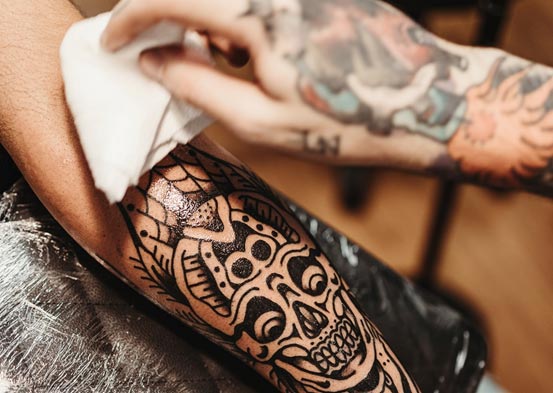Getting a tattoo is a unique form of self-expression, but for many, the pain associated with the process can be a deterrent. This is where Tattoo Numbing Cream comes into play, providing a solution for those seeking a less painful experience. However, selecting the right numbing cream for your skin type is crucial for a successful outcome. In this guide, we’ll explore the factors to consider and provide valuable insights on choosing the perfect Tattoo Numbing Cream tailored to your skin.
Table of Contents
Understanding Your Skin Type
Before delving into the world of Tattoo Numbing Creams, it’s essential to understand your skin type. Different skin types react differently to various products, and choosing a cream that aligns with your skin’s characteristics is imperative for optimal results.
Sensitive Skin
Sensitive skin is prone to redness, irritation, and allergic reactions. When selecting a Tattoo Numbing Cream for sensitive skin, opt for formulations that are hypoallergenic and free from common irritants like fragrances and artificial colors.
Normal Skin
Normal skin types are well-balanced, and not excessively oily or dry. For normal skin, you have a wider range of options. Look for a Tattoo Numbing Cream that provides a good balance between numbing effectiveness and skin compatibility.
Oily Skin
Oily skin tends to produce excess sebum, which can affect the absorption of numbing creams. Choosing an oil-free or water-based formula is recommended for individuals with oily skin to ensure the cream penetrates effectively.
Dry Skin
Dry skin lacks moisture and can be prone to flakiness and roughness. For those with dry skin, opt for a Tattoo Numbing Cream with moisturizing properties to prevent further dehydration during the tattooing process.
Factors to Consider When Choosing a Tattoo Numbing Cream
Active Ingredients
Look for creams containing lidocaine, prilocaine, or benzocaine as active numbing agents. These ingredients are widely recognized for their efficacy in numbing the skin’s surface.
Formulation
Tattoo Numbing Creams come in various forms, including creams, gels, and sprays. Consider which form you find most comfortable to apply and ensure it aligns with your skin type.
Duration of Numbing
Some numbing creams provide temporary relief, while others offer prolonged numbing effects. If your tattooing session is expected to be lengthy, opt for a cream with a longer-lasting numbing effect.
Allergen-Free Formulas
If you have sensitive skin, prioritize Tattoo Numbing Creams that are labeled as hypoallergenic and free from common allergens to minimize the risk of adverse reactions.
Consult Your Tattoo Artist
Your tattoo artist is a valuable resource in this process. They may have specific recommendations based on their experience and the products they prefer to use.
Application Tips for Optimal Results
Once you’ve selected the right Tattoo Numbing Cream, follow these application tips for the best possible outcome:
Patch Test
Before applying the cream to a larger area, conduct a patch test on a small section of your skin to ensure you don’t have an adverse reaction.
Cleanse and Dry the Skin
Start with clean, dry skin to ensure the numbing cream is absorbed effectively.
Apply a Thin, Even Layer
Avoid over-applying the cream. A thin, even layer is all you need for effective numbing.
Cover and Wait
Depending on the product’s instructions, you may need to cover the area with plastic wrap. Follow the recommended wait time for the numbing cream to take effect.
Additional Considerations
1. Concentration of Active Ingredients
When selecting a Tattoo Numbing Cream, pay attention to the concentration of active numbing agents. Different products may contain varying percentages of lidocaine or other numbing ingredients. It’s crucial to strike a balance that works effectively for your skin without compromising safety.
2. Duration of Action
Consider the duration of numbing provided by the cream. Some products offer quick-acting relief that lasts for a shorter duration, while others provide a slower onset but longer-lasting numbing effect. Consider the specific requirements of your tattooing session, such as the size and complexity of the design, to determine which type of numbing cream is best suited for your needs.
3. Feedback and Reviews
Prior to making a purchase, take some time to research and read reviews from other users. Look for testimonials from individuals with similar skin types to get a sense of how effective the Tattoo Numbing Cream is likely to be for you.
4. Compatibility with Tattoo Inks
It’s important to ensure that the numbing cream you choose is compatible with the type of ink your tattoo artist will be using. Some formulations may interact with certain inks, potentially affecting the quality and longevity of your tattoo. Consult with your tattoo artist about any specific recommendations they have regarding numbing creams and ink compatibility.
5. Hydration and Aftercare
Following the tattooing process, proper aftercare is essential for the healing process. Some numbing creams may contain moisturizing agents that can be beneficial for post-tattoo skin care. Consider whether the cream you choose provides any additional hydrating or soothing benefits that can aid in the recovery process.
6. Consult a Dermatologist
If you have specific concerns about how a Tattoo Numbing Cream may interact with your skin type, it’s advisable to consult with a dermatologist. They can provide personalized recommendations based on your unique skin characteristics and any pre-existing conditions you may have.
Conclusion
Choosing the right Tattoo Numbing Cream for your skin type is a crucial step towards a more comfortable tattooing experience. By understanding your skin type and considering key factors in product selection, you can ensure a successful and pain-free tattoo session. Remember to consult your tattoo artist for their expertise, and always follow recommended application guidelines for the best results. With the right numbing cream, you can focus on the artistry of your tattoo without the distraction of pain.

